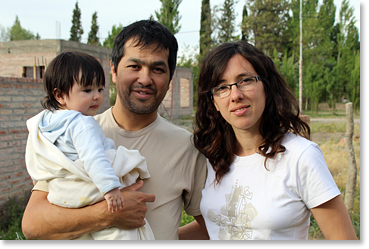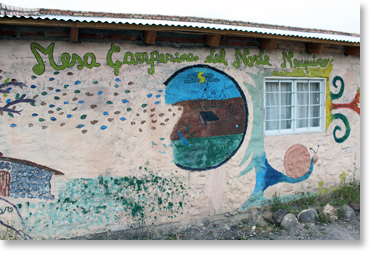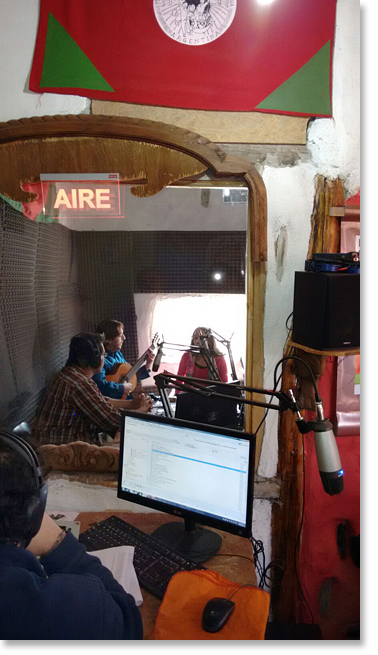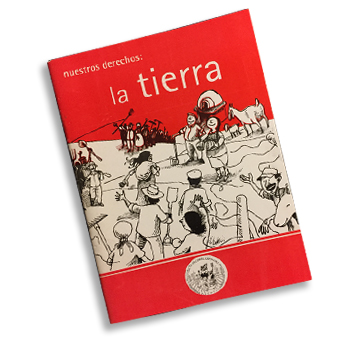|
Interview with Luciana Monacci
Quick Links:
In Motion Magazine: First, can you please talk a little about your history and why you are a member of La Mesa Campesina del Norte Neuquino? Luciana Monacci: OK, I am Luciana. I have been part of La Mesa since 2006, more or less. Why am I part of La Mesa? I would suppose it has to do with my history of activism. Ever since I was a young girl, since I was in high school, I have been active in different arenas (spaces), and I have always sought horizontal spaces where everyone is equal in making decisions. (And) I am an agronomy engineer. La Mesa Campesina embraces the inter-connectedness of life from a viewpoint of solidarity, shall we say, from putting oneself in the place of others, that “my problem is everyone’s problem.” And so, yes, it is good that La Mesa Campesina del Norte Neuquino embraces as many people in the countryside as in the city, because to fight for this type of countryside, as we do, means to fight for working families without bosses transcends the countryside, it also involves a model city. And well, from La Mesa, we are working for the right to the land, to water, to health, to education, to a job. Those of us in La Mesa, we suffer discrimination all the time, and well, we are going to fight for those things for all. I am one more member let’s say, even though I live in the city, we are all Mesa Campesina. In Motion Magazine: Are your family from the countryside? Luciana Monacci: My great grandparents were from the country. My grandparents, on my mother’s side, were not peasants but laborers. Let’s say we come from oppressed sectors, since I don’t differentiate between city and countryside. I don’t know why I have this interest, I don’t know. I don’t attribute it to my roots or my history. Perhaps I should investigate a little. For me, it’s more a matter of common sense, being active in an organization. I don’t feel complete if I don’t do it. How life was for my whole family In Motion Magazine: And (to Fabian) a little of your history? Fabian Beltrán: Well, I am Fabian. And this is Ema (he is holding their baby daughter). I have participated in the organization since 2008, more or less. My political activism has lasted a little longer because I am a native of Buta Ranquil, a town which is close to the border with (the province of) Mendoza, and I participated there in city politics. I was a city councilmember in that town for four years, and, well, my political activism came even before that, (but) in the city council there arose some unfortunate things, the matter of La Tungar, which you interviewed people about today (link to the Tapia Sisters interview). From that moment on, from my role as a council member, I began to participate in the organization (La Mesa Campesina). And later I quit the partisan approach and I went on as an activist in the struggle in the organization for the same reasons that Luciana was talking about, right? For the type of structure that the organization has which is more horizontal (while) in the other sphere in which I was previously involved, let’s just say that it was more of a matter of being vertical and with a solely electoral participation, acting was based on how many votes you could get and, basically, was not action based on transforming society. With regards to my life, I come from a family of campesinos. My great-grandparents, my parents all were country folk; they were born and raised in the country. And because of this situation that arose of very large families, the whole family could not be sustained in the countryside. On my mother’s side, they were a family of 18, in total. Many died, some prematurely, others at birth. (The infant mortality rate in the countryside was quite high in this era. I am talking about the ’40s, more or less.) And on my father’s side, there were 24 brothers and sisters in total, from the same father and two different mothers, shall we say. But the total number of siblings was 24. So, (yes) they were very large families that weren’t able to sustain themselves. As a result, my parents left the countryside -- when my father was sixteen and my mother was eighteen. They went to work in town. And so I believe my activism comes from that, let’s say, from knowing how life was for my whole family, before me, that they all lived in the country. And also it (my activism) began when I was at the university and I began to understand a little bit about how the world functioned, seeing this matter, as Lu was saying, as one of common sense -- the injustices and how one as an individual can take action to transform those things that one sees as being wrong, not only with words but with action. Damages caused by the model implemented by Menem In Motion Magazine: Was the 2001-2002 economic crisis important for all of you? Fabian Beltrán: The crisis let loose in 2000, 2001, specifically, but the (neoliberal) model began in the ’90s. The families, our families were damaged by that model which (President Carlos) Menem implemented. Our education, partly in high school and partly in university, took place in that context. So, yes, it is necessary to see that. So, starting around ’95 with the piquetero movements, and up till 2001 when we were in university, in that context we were trained/educated. So I believe that it is directly linked with that also. In Motion Magazine: And the beginning of La Mesa Campesina? Luciana Monacci: La Mesa Campesina began in the year 2000, more or less. It began, but nothing was like it is now. In reality, it was brought together by institutions, primarily the church, which called together the herders so that they could express what were their land problems and in that process try to end a very paternalistic way of thinking, let us say. No? Well, La Mesa Campesina del Norte Neuquino (Northern Neuquino) began in that way. (But) there was a point in 2003, more or less, when it was falling under its own weight because there weren’t that many results and, in part, because herders were coming (just) once a month to Chos Milal to say what their problems were, bringing their papers, to get them resolved. So, the church asked for help from other institutions such as INTA (the National Agricultural Technology Institute), a special agricultural program at that time, and from a union in CTA (Argentine Workers' Central Union). They set up an institutional committee in which, for example, INTA put a little of its methodology into the organization. That project marked the point at which the organization became community-based. Herders in this area joined together and representatives came to Chos Milal to present their problems and in that process began to try to accelerate their resolution, (but) always from a very institutional way of thinking. Some of us experts, who were connected to the institutions, we saw at that moment that in reality what was missing was another turn of the screw; that in reality it was all very well to work with the institutions but the organization had to have its own identity and its own bodies to make decisions. In other words, the issues that were being talked about were put in place by the institutions, and it ended up being like a space for the development of projects for those institutions. We began to work on the question of representation, of leaving the institutions out of the organizational structure of La Mesa. This was, more or less, 2006 when this situation occurred, of seeking to resolve institutional dialog problems -- deeply felt problems with land, problems with water, (when) we met MNCI (the Indigenous Peasant National Movement), (http://mnci.org.ar). There was an exhaustion of that type of institutional work. No? Of allying ourselves with the provincial (institutional) method of resolving land problems, which gave us no answers, and then later they (the intsitutions) would come and do whatever thing they wanted in their inspections. So, La Mesa began to make decisions as Mesa Campesina without consulting with the institutions. And here there was a major break with the institutions. The church threw us out of the Salesian patio, which was where we used to meet. INTA withdrew our financing, and some compañeros were fired from their institutions. But, despite this, the social agricultural program continued working. In 2006, more or less, La Mesa began to take the form that it has today, which is community-based groups in zones where herders from nearby places meet to discuss their problems and elect representatives who come every two months to an assembly in Chos Malal. These representatives always go to the same work areas. When they come to Chos Malal they work on land programs and water problems, on production, issues dealing with the organization’s economy, and communication. Also, they negotiate with the institutions. That is to say, that if we need a project: we formulate it, and we go and present it. Today we have legal standing also. We, the organization, prioritize what issues to work on and in the process of that we have linked up with the institutions. That break was very positive, it permitted us to grow a lot. There was a time when there were no replies to the notices which we sent to the institutions to resolve problems. So, La Mesa decided to take direct action at that time. For example, a small herding trail that was closed was opened to let the animals pass; a wire fence was raised in the field of a woman peasant in Pichi Neuquén where they weren’t letting her pass to search for wood and water. They stopped caterpillar tractors that wanted to tear down a house. There was a series of actions that they took which made the institutions retreat. They wanted La Mesa to disappear and, well it was good, perhaps, they reduced us in numbers of people because obviously when you acquire that identity there are people who pulled back, but it has greatly strengthened the organization and that is the process that has made us who we are today. And well, in 2007 we joined up with MNCI, the Indigenous Peasant National Movement of which today we are a part. In Motion Magazine: How many people are there in La Mesa Campesina? Fabian Beltrán: There are around 120 families in La Mesa. 120 families, not individual members, families. There are 10 base communities, that is to say 10 zones in all of the organization. In Motion Magazine: Can you talk about the social economy in La Mesa? Luciana Monacci: When we began, in the organization, to work on production questions, we began with rotating funds. Funds that today still work to improve property taxes in the countryside – such as sheds for animals or enclosures for produce farms. Distinct funds. There are distinct funds that compañeros use to buy materials and afterwards they return the loan and in that way we continue making improvements in the fields of the different compañeros. In regards to the sale of animals or products from goat husbandry, there have been experiences, such as more than anything the sale of hides, which is a byproduct that hasn’t been commercially explored very much. Because the commercialization of goats already has its own function, its own dynamic, which functions well in the zone (its own area) in general. It could be said, that it is something that could be improved, but there is no need to work to improve it. It’s just that the people keep the goats and don’t know who to sell them to. You see? What has been worked on a lot in the organization is the development of other products. Peasants don’t grow mono-crops, the young people don’t do that, they make vegetable gardens, fruit trees, everything on a family scale. So, they make sweets, jams, health products – different things have been made by production groups. Those groups are those who sell textiles and yarn in the outdoor markets. They sell them in the organization’s outdoor markets and from the sales of the products we set aside 10 percent to sustain ourselves or it is sent to the movement’s networks, for example to Buenos Aires. The organization SERCUPO (Popular Culture Service) sells all of the movement’s products throughout the country. We have passed through a period with complications, since the institutions withdrew, as I was telling you, of very little money in the organization. Now perhaps we are going to be taking on some larger projects that will permit us to make some strides in production. Up until now we have been half-subsisting (laughs) with regard to the organization’s finances. But, yes, the production area is operating very well. In Motion Magazine: So, do La Mesa members sell to other members of La Mesa, or to people in general? Luciana Monacci: When we do open air markets, they are open to the community. For example, in networks within the organization we sell among ourselves, but also we are open to the community and we also send products to Buenos Aires so they can be sold somewhere else. In Motion Magazine: And compañeros sell as a group or as individuals? Luciana Monacci: There are production groups and also there are products that are for the families. In Motion Magazine: Are there cooperatives? Luciana Monacci: We are setting up two cooperatives which are going to have production groups within them. But up until now we haven’t had cooperatives in the organization, in La Mesa. In Motion Magazine: And, (as you say) ten percent of what you make goes to the organization? Luciana Monacci: Yes, to the organization’s common fund. The rest goes to the producer. When we do an open air market, we have a chart with the products of all the compañeros, with all the prices, and one representative from each zone sells the products for everyone. Then, afterwards we have a settling of accounts, and well, from everything that is sold, 10% is set aside and put into the organization’s common fund. As far as having enough money for autonomy, let’s just say that we don’t owe anyone anything. We are tending towards autonomy but we are not autonomous. We are tending towards autonomy. We are in the process of increasing the scale of production. It is very small. These are like very small experiences. Schools: do not adapt to life in the countryside In Motion Magazine: Can you talk about your work in education? Luciana Monacci: Two years ago, when we began to work through the organization’s problems, secondary education came up a lot. Which is to say there is access to primary school, but there was a lot of dropping out from High School education because the schools were not adapting to life in the countryside. In general, the young people have to come to the towns to be able to study. There was a lot of uprooting, and those who finished (school) at the end did not return afterwards to the country. So, as a result of our getting to know MNCI, we began to work on the idea of having our own middle (secondary) school. UST of Mendoza (Unión de Trabajadores Rurales Sin Tierra de Mendoza) (Mendoza Landless Rural Workers Union), part of MNCI, had experience with agroecology schools; also the Campesino Movement of Cordoba (El Movimiento Campesino de Córdoba) and MOCASE (The Campesino Movement of Santiago of Estero) (Movimiento Campesino de Santiago del Estero). And so we began with that idea. We are in the process of running that school and also we are beginning to work on adult literacy because we have many compañeros who do not know how to read and write, or are functionally illiterate. Many years ago they went to primary school but they can barely sign their name. So, well, we are introducing training processes from popular education seeking to advance our school, (so) that these education activities can be recognized by the province -- so that afterwards the compañeros can continue studying. Already we have a place. We are going to create the school in the countryside. This provokes the uprooting of the youth Fabian Beltrán: It is not just the matter of secondary middle school that is being tackled here, but also literacy -- there are many compañeros who don’t know how to read and write -- and the completion of primary school. These are all parallel actions being conducted by this education group in order to have the possibility of covering all the necessary education levels, that they be adapted to logic, or to the idiosyncrasy of the countryside, let’s just say, of how people live in the country -- the way of life in the countryside. And so, what is the problem? The school is implanted in a system that is already set. That is to say, from Monday to Friday, (there is) a specific schedule and it is not adapted to how people live in the country, basically -- or to the times or periods of work in the country. This provokes the uprooting of the youth, or the children, who go to school. And afterwards they don’t return to the country because, basically, they lose their connection (to the country) -- It’s like the school separates them from that way of life. And so, what is intended with the education within the organization is to adapt it to the schedule of the peasant family. Currently, it is the season of the “parición”, the birth of baby goats, you see? From the end of August until October it is the time for the birth of all the goats. It is time for a lot of work for the farmworker family -- and the whole family works. In a regular, common school that cannot be accomplished because the kids are in school and so only the parents or the elders are left, or only one person from the family, is left working in the field during this time. And so the school needs to adapt to these times. In regards to “transhumancia”, the migration from the winter pasture to the summer pasture, and vice versa, the school needs to adapt to those times of the peasant life. This can be thought of as an education that concentrates on certain days of study, on more theoretical matters, in a specific place, in a building for some 15 days, and then 40 or 45 days in the country doing school activities but being able to work in the field. Luciana Monacci: That is the issue of rotation/alternation. It is called school time and community time. The proposition is that the young people come to study intensively during a short period for these 15 days, that Fabi mentioned. And, afterwards, they return to the country to do tasks and there is a tutor in the paraje (small administrative district), or in the zone, who helps them to do the work that is being discussed at school for 45 days. Afterwards they return again (to school). In Motion Magazine: And the tutors are members of La Mesa? Luciana Monacci: Yes, of course. In Motion Magazine: And is this certified by the government? Luciana Monacci: We are seeking the backing of the government -- that our school be validated by the government. Fabian Beltrán: That is the most difficult of all! (laughs) In Motion Magazine: How long ago …? Luciana Monacci: It has been two years that we have been putting together the idea within the organization in order to put it into practice. In Motion Magazine: How old are the students? Luciana Monacci: All ages. There are more or less 60 compañeros who want to finish high school, to begin and/or finish and they are from 18 to 55 years old. And there are many who want to learn to read and write. In Motion Magazine: They have their own secondary school (high school) in Zanón. (Interview with Jorge Bermúdez Of FaSinPat / Factory Without Bosses and Zanón Ceramics). Luciana Monacci: We have met with them to learn from their experience. In Motion Magazine: Thank you.
|
||||||||||||||||||||||
If you have any thoughts on this or would like to contribute to an ongoing discussion in the  What is New? || Affirmative Action || Art Changes || Autonomy: Chiapas - California || Community Images || Education Rights || E-mail, Opinions and Discussion || En español || Essays from Ireland || Global Eyes || Healthcare || Human Rights/Civil Rights || Piri Thomas || Photo of the Week || QA: Interviews || Region || Rural America || Search || Donate || To be notified of new articles || Survey || In Motion Magazine's Store || In Motion Magazine Staff || In Unity Book of Photos || Links Around The World NPC Productions Copyright © 1995-2017 NPC Productions as a compilation. All Rights Reserved. |






